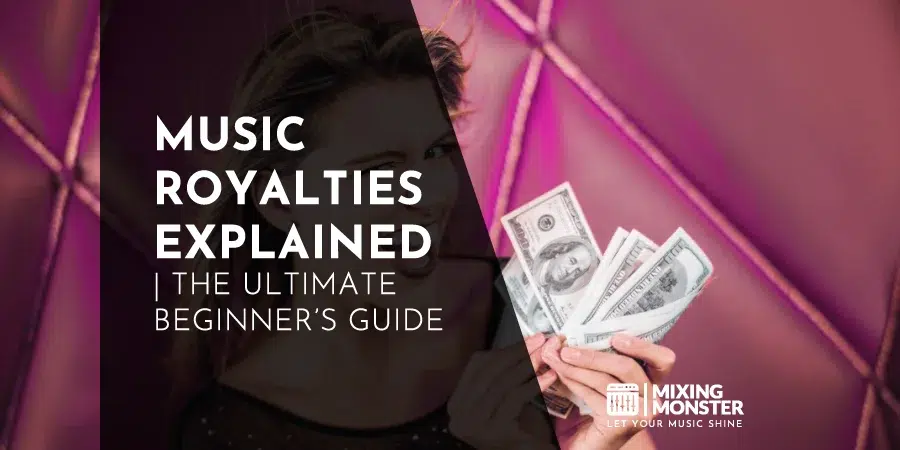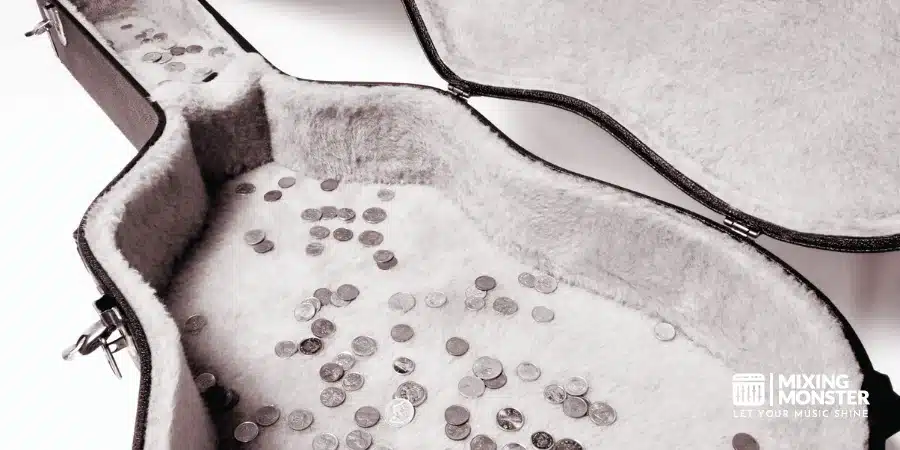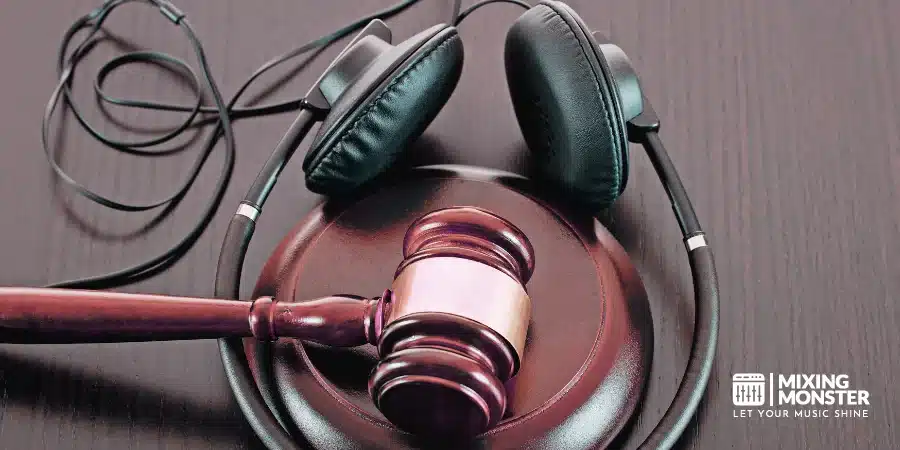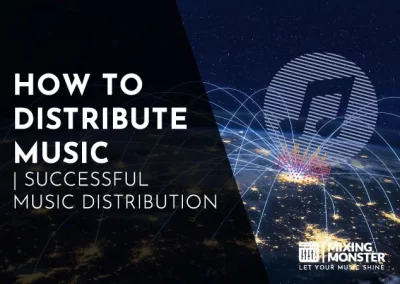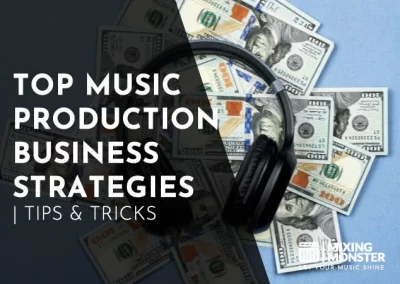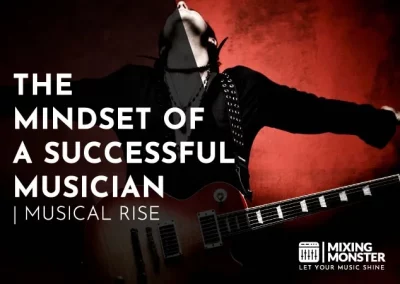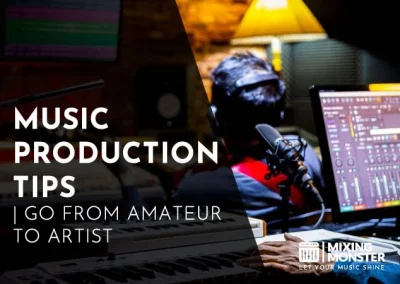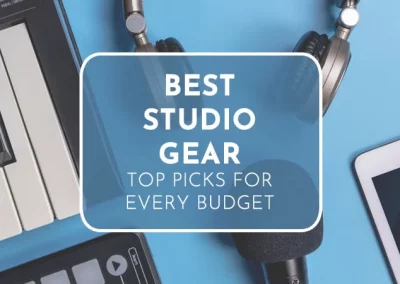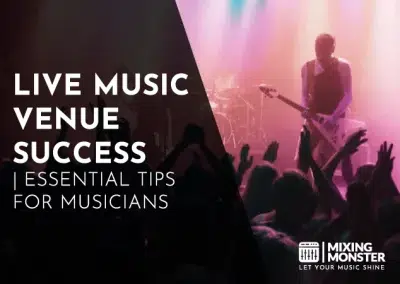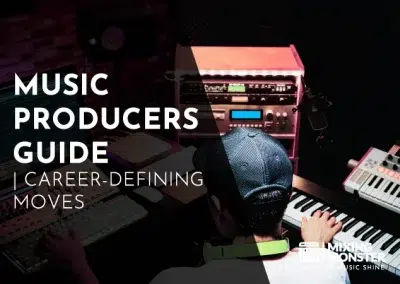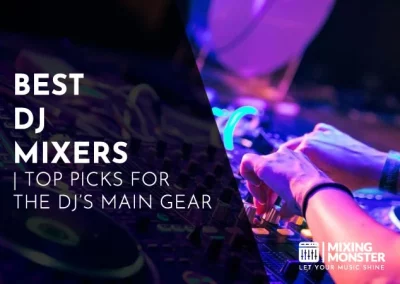Home > Blog > Music > Music Industry
Disclosure: Some of the links below are affiliate links, meaning that at no additional cost to you, we will receive a commission if you click through and make a purchase. Read our full affiliate disclosure here.
Every time your favorite song comes on the radio, streams online, or pops up in a commercial, somebody’s getting paid. Music royalties are basically the lifeblood of the music industry, sending money back to the folks who create the stuff we listen to every day.
Music royalties pay rights holders—songwriters, composers, recording artists, and their teams—whenever their music gets used commercially. Usually, they get somewhere between 10% to 25% of suggested retail prices in traditional deals. Royalties break down into a few main buckets: performance royalties, mechanical royalties, synchronization fees, and digital performance royalties. Each one’s tied to a different way music makes money.
If you’re a musician—or even just thinking about dipping a toe into the industry—understanding royalties isn’t optional. The system for collecting royalties is, well, a bit of a maze.
There are organizations called Performing Rights Organizations (PROs) that handle tracking, collecting, and paying out royalties. These folks try to make sure artists get what they’re owed for their work, though it’s not always as smooth as you’d hope.
KEY TAKEAWAYS:
- Music royalties are a significant income source, coming from performance, mechanical, and synchronization payments, among others.
- Rights holders generally get 10-25% of retail prices, split between songwriting and publishing.
- Registering with the right collection organizations is crucial if you want to maximize your royalty earnings from your music.
Table Of Contents
1. What Are Music Royalties And Why They Matter
2. The Major Types Of Music Royalties Explained
3. How Streaming Platforms Pay Music Royalties
4. Music Publishing Royalties Demystified
5. Performing Rights Organizations (PROs) And Their Role
6. Music Royalty Collection And Distribution Timeline
7. Legal Frameworks And Music Royalty Legislation
8. Key Takeaways On Music Royalties
FAQ

1. What Are Music Royalties And Why They Matter
Music royalties are the backbone of the industry—they’re how creators get paid when their work gets used. If you’re making, distributing, or even just licensing music, you need to understand how these processes work.
The Definition And Purpose Of Music Royalties
Music royalties pay rights holders like songwriters, composers, recording artists, and their teams. For many music creators, these payments are the main way they make a living. It’s what keeps the lights on and the music coming.
Royalties exist to protect creative work and keep artists motivated to keep creating. If there wasn’t a system for this, who would bother writing the next big hit?
Royalty systems give legal weight to creative ownership. They set up a process for figuring out and paying what’s owed when music gets streamed, played live, broadcast, or used in movies and ads.
The whole industry leans on these licensing payments to keep running. It’s what lets artists actually make a living doing what they love.
Types Of Music Rights That Generate Royalties
There are two big buckets of music rights, and each one brings in its own kind of royalty check:
Composition Rights (Publishing):
- Songwriters and composers own these
- Cover things like melody, lyrics, and arrangement
- Bring in mechanical and performance royalties
Master Rights (Recording):
- Recording artists and labels own these
- Apply to the actual sound recording
- Earn streaming royalties and master use fees
Different uses trigger different royalty types. Performance royalties come in when songs get played publicly—think concerts, radio, TV. Mechanical royalties kick in when music is copied or distributed.
Synchronization royalties show up when music gets used alongside video, like in movies or ads. And then there are print royalties from sheet music sales or lyric displays, which, yeah, still exist.
The Evolution Of Music Royalties
Royalties have changed a ton over the years. Back in the day, it was mostly about sheet music sales and live performances, and honestly, tracking was a mess.
When radio came along in the 1920s, it opened up new ways to make money (and new headaches for collecting it). TV took things further in the mid-1900s.
Then digital changed everything. Physical sales plummeted, and streaming took over. Suddenly, royalties started getting calculated per stream instead of per album or single sold.
Now, it’s all gotten complicated. Global streaming platforms mean you need some serious tech to keep track of who gets paid. People are even experimenting with blockchain and smart contracts to make royalty payments more transparent and faster.
Royalty rates—especially from streaming services—are a huge source of debate, since artists often see just fractions of a penny for each play. Is that really fair? Depends on who you ask.
Who Benefits From Music Royalty Systems
A lot of people get a piece of the royalty pie in the music world:
Primary Beneficiaries:
- Songwriters and composers
- Recording artists
- Music publishers
- Record labels
Secondary Beneficiaries:
- Performing Rights Organizations (PROs)
- Mechanical rights agencies
- Producers and engineers
- Session musicians
Royalty collection societies like ASCAP, BMI, and SESAC handle the heavy lifting—tracking plays, collecting money, and paying out to rights holders.
Usually, music publishers and songwriters split publishing royalties 50/50. Recording royalties get divided between artists and labels, but those deals are all over the map.
Indie artists tend to keep more of their royalty rights than those on big labels, but they might not have the resources to chase down every dollar. There’s always a tradeoff.
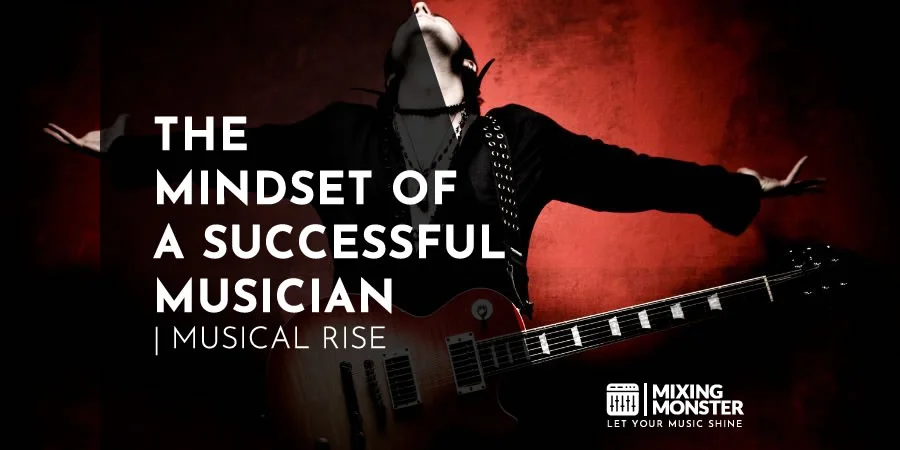
2. The Major Types Of Music Royalties Explained
Music royalties pay rights holders for using their music. Knowing the types helps artists figure out where their money comes from and how actually to collect it.
Performance Royalties: Live Shows And Broadcasting
Performance royalties show up whenever music gets played in public—live shows, radio, TV, or even streaming platforms. Performance Rights Organizations (PROs) like ASCAP, BMI, and SESAC in the U.S. (and their counterparts worldwide) collect these payments.
Artists and songwriters must register with PROs to receive payment. These organizations track public performances using digital monitoring, reports, and sometimes just good old-fashioned sampling.
Typically, they split the money 50/50 between songwriters and publishers. How much you get depends on a bunch of stuff—how big the audience was, where it played, and how often it aired.
For many musicians, performance royalties are a significant portion of their income, especially if their songs are radio staples or performed at major gigs.
Mechanical Royalties: Physical And Digital Reproduction
Mechanical royalties show up whenever music gets reproduced—think CDs, vinyl, downloads, or even streaming. These royalties compensate songwriters and publishers when their compositions are reproduced.
In the U.S., mechanical rates for physical products and downloads sit at 9.1 cents per song under 5 minutes. Streaming rates? The Copyright Royalty Board determines those, and the math gets pretty tangled.
Spotify, Apple Music, and other digital platforms generate mechanical royalties through their subscriptions and ad-supported models. Organizations like the Harry Fox Agency or Music Reports usually scoop up these royalties and distribute them.
Independent artists can collect mechanical royalties via distributors such as DistroKid, CD Baby, or TuneCore. These services help artists actually get paid when their music pops up on various platforms.
The shift from physical to digital has completely transformed how mechanical royalties are distributed. Figuring out these systems is basically a must for any musician trying to make sense of the modern landscape.
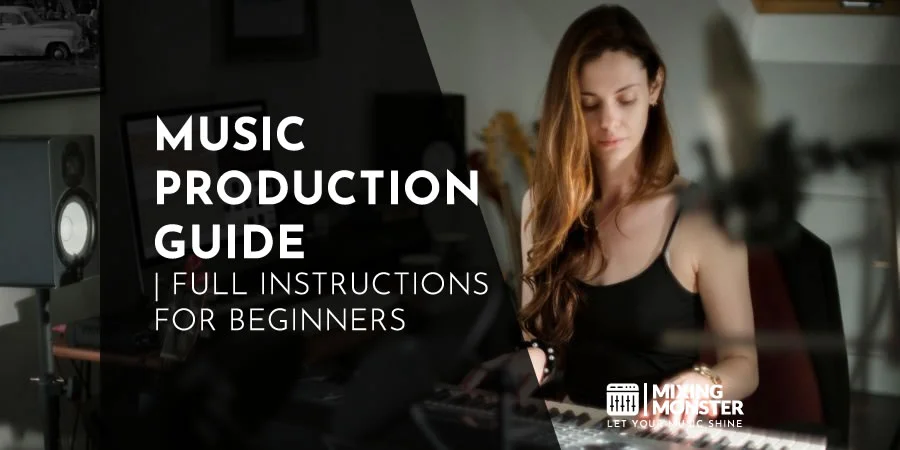
Synchronization Royalties: Film, TV, And Advertising
Synchronization (sync) royalties arise when music is paired with visual media—movies, TV, ads, video games, you name it. These licensing agreements get hammered out directly between rights holders and content producers.
Sync deals usually mean an upfront fee plus backend royalties every time the content airs or streams. The money can range from a few hundred bucks to six figures, depending on where the song lands, what kind of media it’s in, and how well-known the artist is.
Both the master recording owner (often the label) and the composition owner (songwriter or publisher) have to sign off before anyone uses a song for sync.
Sync licensing has become increasingly important as other revenue streams have dried up. TV shows like “Grey’s Anatomy” and “Breaking Bad” have catapulted songs into the spotlight just by picking the right track at the right moment.
For indie artists, sync licensing is a real shot at making money—libraries and placement agencies can help musicians connect with filmmakers and content creators hunting for fresh sounds.
Print Royalties: Sheet Music And Lyric Licensing
Print royalties come into play when sheet music, tablature, or lyrics get reproduced and distributed. It’s not the most significant chunk of the royalty pie, but print rights still matter, especially for classical composers and educational publishing.
Publishers usually handle print rights and collect royalties for composers and songwriters. Traditional print royalties come from selling songbooks, method books, or individual pieces of sheet music.
Digital print licensing has really taken off thanks to services like Musicnotes and Sheet Music Plus. These platforms open up new distribution channels and help composers actually get paid for digital copies.
Lyric licensing brings in revenue when lyrics appear in merchandise, books, karaoke apps, or on websites. Companies need proper licenses to display lyrics, and payments usually flow to publishers, who pass them along to songwriters.
For composers in educational and religious spaces, print royalties can actually add up—specialized channels target schools, churches, and community groups.

3. How Streaming Platforms Pay Music Royalties
Streaming platforms pay royalties through complicated systems, and every service has its own quirks. Most use a pro-rata model, splitting up the total payment pool based on each artist’s share of streams. If you’re an artist, getting a handle on these systems is almost a survival skill now.
Streaming Royalty Rates Across Major Platforms
Spotify—probably the most recognizable streaming platform—pays between $0.003 and $0.005 per stream, give or take. This number isn’t set in stone; it shifts depending on several factors. Apple Music usually pays a bit more, while Tidal and Amazon Music land somewhere in the middle.
YouTube Music generally pays less per stream than the dedicated music platforms.
These rates change based on things like:
- Subscription tier (premium or free users)
- Where the listeners are located
- Currency exchange rates
- Whatever deals the platform has struck with major labels
The money gets split up between different rights holders. About 85% of royalties go to master rights holders, and the rest trickles down to publishers and songwriters.
The Pro-Rata Model Vs. User-Centric Payment Systems
Most streaming platforms stick with the pro-rata model for royalty distribution. Basically, all tracks get paid from one big pool, and it’s divided up based on stream counts. So if your tracks make up 0.1% of all streams in a month, you get 0.1% of that month’s royalty pool.
Many people complain that this system favors the most prominent artists. Some platforms have started poking at user-centric payment systems (UCPS) to see if there’s a better way.
UCPS would mean each subscriber’s monthly fee only goes to the artists they actually listened to. If you only stream indie acts, your money supports them directly, rather than being spread across the entire platform.
Fans of UCPS say it’s fairer, especially for niche genres and indie musicians with loyal listeners. Detractors aren’t so sure—implementation sounds tricky, and it’s unclear if it would really shake up who gets paid.
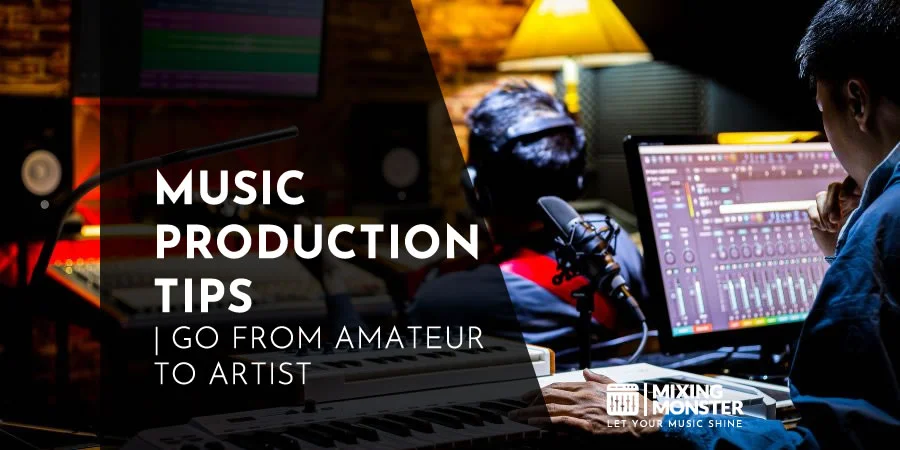
How Algorithm Changes Affect Royalty Distribution
Streaming platforms like to tinker with their algorithms, and every tweak can totally change how music gets discovered—and who gets paid. If a platform shifts its recommendation engine, some artists suddenly find themselves front and center, while others get buried.
Landing on a featured playlist can send an artist’s streams through the roof overnight. Changes that favor specific genres, song lengths, or even listening habits can significantly impact royalty distribution.
Some of the algorithmic factors that play a role:
- Playlist placement algorithms: Deciding what makes it onto editorial or algorithmic playlists
- Skip rates: Listener behavior that affects future recommendations
- Release timing: How new tracks get pushed in discovery features
- Engagement metrics: Saves, shares, and repeat listens all feed into recommendations
Artists really have to keep an eye on these shifting sands and tweak their release strategies if they want to stay visible in this algorithm-obsessed world.
Maximizing Your Streaming Royalty Income
There are a few ways artists can boost their streaming royalty income. Building a real relationship with fans pays off—repeat listeners mean more royalties, simple as that.
Pitching tracks to playlists is a must. Artists should target both editorial and user-curated playlists that actually fit their vibe. Making your own playlists and mixing in your tracks with similar artists can also help new listeners stumble across your music.
Owning your master rights is a game-changer, since it means you keep the most significant chunk of streaming royalties. If a label owns your masters, they often take 50-85% before you see anything.
Don’t forget to spread your music around. Spotify might have the most users, but Tidal and Apple Music sometimes pay more per stream. Interactive streaming platforms pay differently than non-interactive, radio-style services—so yeah, learning how each one works is worth your time.

4. Music Publishing Royalties Demystified
Publishing royalties are basically the lifeblood of the music industry, fueling income for songwriters and composers. Every time a song gets used—recorded, performed, streamed, whatever—those royalties kick in and start flowing.
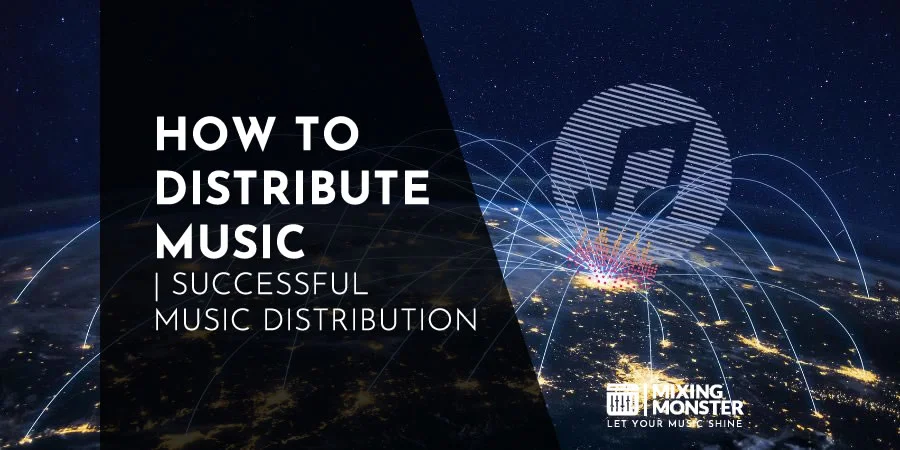
The Role Of Publishers In Collecting Royalties
Music publishers step in as the go-between for songwriters and the maze of royalty collection. They’ll register your songs with performance rights organizations and mechanical licensing agencies like the Harry Fox Agency to make sure you get paid.
Publishers chase down licensing opportunities and keep tabs on where and how your songs are used. They handle the paperwork, track everything, and collect royalties from all over the globe so you don’t have to.
Most publishers take a cut—usually somewhere between 25% and 50%—as payment for all this. The exact percentage depends on your deal and what the publisher actually does for you.
But publishers aren’t just about collecting money. They’ll also connect songwriters with collaborators, pitch songs to artists, or help land sync placements. That creative matchmaking is sometimes worth as much as the admin work.
Publishing Deals: What To Know Before Signing
Standard Agreement Terms:
- Co-publishing deals (usually a 75/25 split favoring the songwriter)
- Administration deals (publisher takes a 10-20% fee)
- Full publishing deals (publisher owns the copyright, pays advances)
Before you sign anything, really dig into the contract—look at how long it lasts, which countries it covers, and what happens if you want your rights back. Most contracts run 1-5 years, sometimes longer if you hit specific targets.
Advances can be tempting, but read the fine print. You’ll need to pay those back (recoup) before you see more royalty money. Higher advances usually mean stricter rules about who owns what.
Music publishing agreements should clearly outline the royalties the publisher collects and the percentage they retain. If you can, have a music lawyer take a look before you sign. Seriously, it’s worth it.
Self-Publishing Vs. Traditional Publishing
Self-publishing means you keep 100% ownership and collect every penny yourself. The catch? You’ve got to handle all the admin and tracking, which can be a headache. But hey, total control and more money if you can pull it off.
A lot of indie songwriters now use admin services—they’ll handle the royalty collection for a smaller fee (5-15%), so you get most of the money and don’t drown in paperwork. It’s a nice compromise if you’re not ready for a full publisher.
Traditional publishers bring you into their network, offer advances, and help promote your work. They’ve got connections with labels, music supervisors, and all the industry folks you might not know yet.
Which route is best? Depends on where you are in your career, how much admin you want to do, and what you need financially.
If you’re starting, a publisher’s experience can open doors. If you’re established, consider going solo to keep more of your earnings.
International Publishing Rights And Collections
Music royalties made overseas need special handling. Publishers usually team up with sub-publishers or collection societies in each country to make sure you’re getting paid everywhere your music lands.
Every country has its own rights organizations and agencies, each with its own rules, rates, and payment schedules. Honestly, it’s a tangled mess, and publishers have to keep up with all of it.
Some of the big international societies you’ll hear about:
- PRS (UK)
- GEMA (Germany)
- SACEM (France)
- JASRAC (Japan)
If you don’t have someone handling your international rights, you could be leaving money on the table—sometimes a lot of it. Make sure your deal clearly outlines which countries are covered and how royalties are collected in each one.
The language differences and ever-changing copyright laws add to the chaos. Publishers with strong international partners can seriously boost their overseas income compared to going it alone.

5. Performing Rights Organizations (PROs) And Their Role
Performing Rights Organizations (PROs) step in between music creators and the businesses that play music in public. Their job? Make sure songwriters and publishers get paid when their work is performed. They track music usage everywhere—from bars to streaming—and then collect and pay out royalties to the right people.
Major PROs Around The World And How They Work
In the U.S., you’ve got three main PROs: ASCAP, BMI, and SESAC. ASCAP and BMI operate as non-profits, whereas SESAC is a for-profit, invitation-only organization (which is exclusive, honestly).
Globally, you’ll see names like PRS for Music (UK), SOCAN (Canada), GEMA (Germany), and SACEM (France). They use tracking technology and collaborate with sister organizations to monitor music use worldwide.
These organizations offer businesses blanket licenses—so radio stations, streaming platforms, and venues can play whatever’s in the PRO’s catalog. The PRO collects fees based on factors such as audience size, music play frequency, and venue capacity.
Each PRO has its own way of figuring out payouts, usually a mix of exact play counts and sampling. It’s not always perfectly fair, but it’s the system we’ve got.
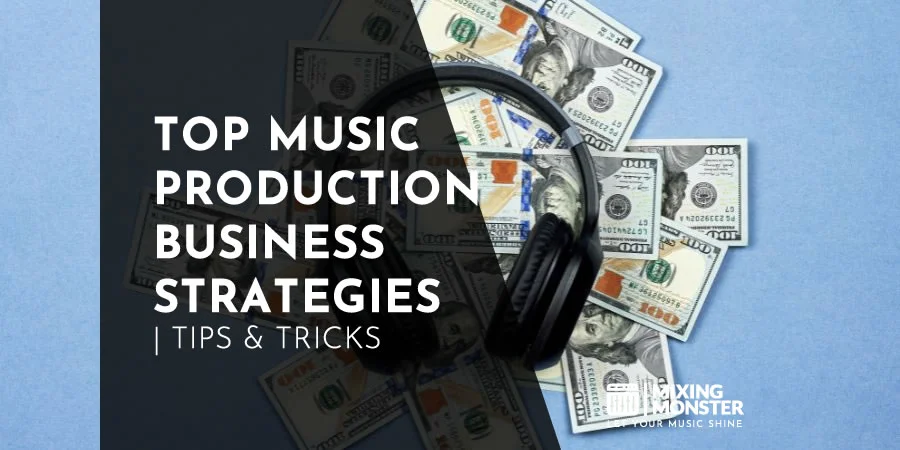
How To Register With A PRO To Collect Royalties
If you want to collect performance royalties, you’ve got to register with a PRO. In the U.S., that usually means picking ASCAP, BMI, or (if you get invited) SESAC.
Registration Process:
- Choose a PRO based on their vibe, fees, and how they treat members
- Fill out the online application
- Pay any registration fees (these vary)
- Register every song in your catalog, including who owns what
You’ll need your real name, stage name, contact info, tax details, and all the nitty-gritty about your songs (like co-writers and publisher splits).
Heads up: songwriters can only join one PRO at a time, but publishers can affiliate with several. It usually takes a few weeks (2-6, give or take) before you see any royalties start to stack up.
Comparing PRO Payouts And Collection Methods
PRO royalty collection methods and payout schedules can significantly impact your income. ASCAP and BMI pay quarterly, SESAC pays monthly—so if you need cash flow, that’s something to think about.
Payment Factors:
- Where your song plays (radio, TV, streaming, live gigs)
- Time of day (prime time is worth more)
- How many people hear it
- Market size (big cities pay better)
ASCAP weighs some performances more heavily than others, and BMI has its own twist on the formula. All PROs take a cut for admin—usually 10-15% for the big ones, sometimes more for the smaller guys.
Streaming adds another layer of complexity, with rates that depend on the platform, whether listeners pay for subscriptions, and a bunch of negotiated details. International royalties? Those take even longer, since they move through different PROs and get processed along the way.
Digital Performance Royalties And SoundExchange
Here’s where things split: SoundExchange collects digital performance royalties for sound recording copyright holders—not songwriters and publishers. Think record labels, artists, and session musicians.
SoundExchange covers royalties from satellite radio, internet radio, cable music channels, and similar places. This is totally separate from what ASCAP, BMI, and SESAC collect (which is just for the composition).
Here’s how SoundExchange splits the money:
- 50% goes to the recording copyright owner (usually the label)
- 45% goes to the featured artist
- 5% goes to non-featured performers (managed by AFM and SAG-AFTRA)
Streaming’s explosion has made these digital royalties a much bigger deal than they used to be. Registering with SoundExchange is a separate process from joining a PRO, and you’ll need to show proof that you own or performed on a recording.
6. Music Royalty Collection And Distribution Timeline
If you’re an artist or rights holder, figuring out when your music royalties will actually land in your account is a big deal for financial planning. The timeline from performance to payout really depends on the type of royalty and the organizations involved.
How Long Does It Take To Get Paid Your Royalties
Usually, it takes anywhere from 3 to 12 months for money to move from a music play to your bank account. Performance royalties—the kind collected by PROs like ASCAP—often show up 6-9 months after the actual performance.
Mechanical royalties from physical sales typically take about 3-6 months to be received after the quarter in which the sale occurred. If you’re relying on streaming, payments usually arrive about 2-3 months after the stream.
International royalties? Those are the slowest, sometimes 12-18 months, thanks to cross-border collection agreements and all the currency shuffling. Your money has to travel through foreign PROs before it gets to your local one, which really drags things out.
And if you’re getting royalties for the first time, don’t be surprised if it takes even longer. Account setup and verification can significantly slow down the process at the start.
Payment Schedules For Different Royalty Types
Performance Royalties:
- ASCAP: Quarterly payments (January, April, July, October)
- BMI: Quarterly distributions (March, June, September, December)
- SESAC: Monthly distributions
Mechanical Royalties:
- Harry Fox Agency: Quarterly payments
- Music Reports: Monthly or quarterly, depending on the source
Digital Royalties:
| Platform Type | Typical Payment Schedule |
|---|---|
| Major Streaming | Monthly (45-60 days after month end) |
| Digital Distributors | Monthly or quarterly depending on service |
| YouTube/Content ID | Monthly (30-60 days after month end) |
Sync licensing payments usually come in 30-90 days after your music is used, though it depends on your contract.
Common Delays And How To Address Them
Registration mistakes cause most payment delays. Double-check that you’ve registered all your songs with the correct metadata—ISRCs, IPI numbers, the whole deal. If your writer and publisher information don’t match, payments can get stuck indefinitely.
If you don’t claim your royalties, they pile up in a database somewhere. It’s worth searching unclaimed royalty databases from Music Reports and PROs now and then.
International delays improve when you join societies with solid reciprocal agreements. If your music does well overseas, think about joining a major PRO in that country directly.
If you spot an accounting dispute, don’t wait around. Keep detailed records—licenses, contracts, usage reports, all of it. If your payment seems off, ask your PRO or publisher for a breakdown.
Digital Tools For Tracking Your Royalty Payments
These days, royalty tracking platforms have really changed how you see your payments. Songtrust gives you a dashboard where you can watch royalties flow in from different societies, all in one place.
Music accounting tools like Sound Royalties or Royalty Exchange offer analytics to help you spot trends and estimate future earnings. They’ll even flag possible missed collections if they notice discrepancies between your performance and payment data.
Blockchain-based platforms are popping up, aiming to make royalty tracking more transparent from start to finish. With automation, you could get paid much faster.
Most major PROs now have mobile apps, allowing you to check performances and pending payments right from your phone. You’ll even get notifications when new royalties are processed, which is pretty handy.

7. Legal Frameworks And Music Royalty Legislation
Music royalty laws form the backbone of how artists and copyright holders get paid. These rules look different around the world and keep evolving as tech keeps flipping the music industry upside down.
The Music Modernization Act And Its Impact
The Music Modernization Act (MMA), signed in 2018, was a massive update to U.S. copyright law. It aimed to make licensing fairer for creators and less of a headache for digital music services. The MMA introduced a blanket licensing system for digital platforms.
The law set up the Mechanical Licensing Collective (MLC), which now handles collecting and distributing mechanical royalties from streaming. This resolved the old song-by-song licensing mess that had left many songwriters unpaid.
Songwriters and music publishers saw significant changes in how they receive statutory mechanical royalties from interactive streaming. The MMA also shifted how royalty rates get set, moving things closer to a market-driven approach.
International Copyright Laws Affecting Royalties
Copyright protection varies significantly depending on your location, making the global music scene pretty complicated. The Berne Convention lays the groundwork for reciprocal copyright protection in 179 countries.
The EU Copyright Directive underwent an overhaul in 2019, enhancing protection for copyright owners and placing greater responsibility on online platforms. Article 17, in particular, addresses how platforms should handle copyrighted content.
Key International Agreements:
- Berne Convention
- WIPO Copyright Treaty
- Rome Convention (for performers and sound recording copyright)
- TRIPS Agreement (Trade-Related Aspects of Intellectual Property Rights)
Collecting societies don’t all play by the same rules internationally. CISAC and similar organizations aim to standardize processes and streamline cross-border royalty collection. These global frameworks significantly influence how artists are compensated when their music goes worldwide.
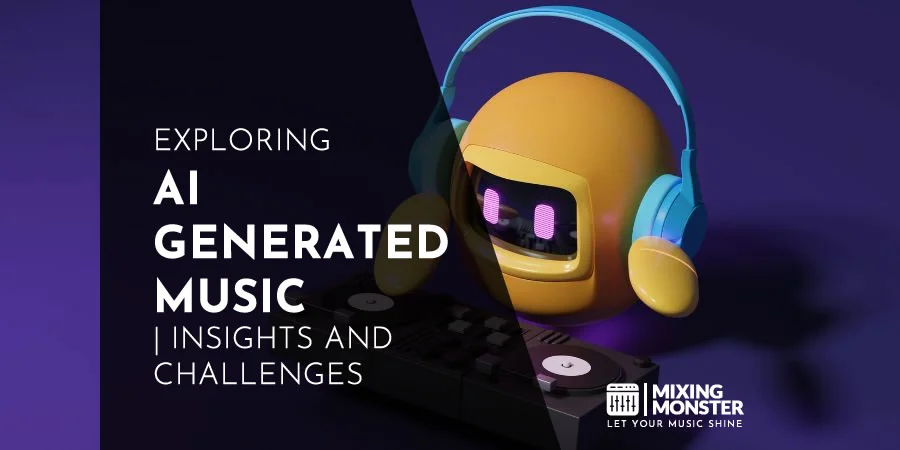
Recent Legal Developments
By 2025, a handful of legal changes will have already left their mark on music royalties. The MMA’s rollout keeps evolving, with the Copyright Royalty Board still tweaking mechanical licensing rates.
Streaming platforms are under increasing pressure to offer fair compensation for both master and publishing rights. Lawmakers are still chasing that elusive “value gap” between what platforms make and what they pay out to rights holders.
The Small Claims Copyright Board, created by the CASE Act, offers a streamlined way to resolve copyright disputes under $30,000. That’s a game-changer for indie creators who can’t afford federal court.
A few recent court decisions have clarified what’s okay when it comes to sampling. Producers who like to chop up existing recordings should definitely pay attention to these rulings.
Royalty-Related Disputes And Resolution Processes
Royalty and copyright disputes are just part of the music business—no getting around it. When things go sideways, you’ve got options, from hashing it out privately to heading to court.
Common Dispute Types:
- Mechanical royalty underpayment
- Performance royalty allocation issues
- Sampling without proper clearance
- Co-writer credit disputes
- International collection gaps
For smaller fights, music rights holders can use the Copyright Claims Board instead of a federal court. That makes legal action way more accessible for indie artists and small publishers.
Mediation and arbitration offer a way to settle things quietly, with experts who actually get the music industry. ASCAP, BMI, and other groups have their own dispute resolution processes tailored to royalty disagreements.
People are looking more at smart contracts and blockchain tech to prevent disputes in the first place. These tools create clear, tamper-proof records of who owns what and who’s owed what, which could save a lot of headaches.
8. Key Takeaways On Music Royalties
Music royalties are payments rights holders receive when their music is used commercially. These rights holders might be songwriters, composers, recording artists, or their reps.
There are two types of music copyright artists really need to know: one covers the composition (lyrics and melody), and the other protects the sound recording. You need both for complete control and to make sure you’re collecting all possible royalty earnings.
6 Primary Types of Music Royalties:
- Performance royalties
- Mechanical royalties
- Synchronization royalties
- Digital performance royalties
- Print music royalties
- Public performance royalties
Digital streaming platforms have completely transformed the way royalties are calculated and paid out. Instead of lump sums from album sales, artists now see tiny payments for every stream.
Music royalties really form the economic foundation of the music world, keeping creators paid long after their song drops.
Publishers, record labels, and collection societies usually step in as middlemen, helping collect and distribute royalties to whoever owns the rights.
Understanding royalties is crucial if you’re an artist who wants to maximize income. More and more musicians see royalties as a kind of passive income—something that can keep their careers afloat over time.
The global market for royalties continues to expand as new technologies and platforms introduce additional ways to license and consume music.

FAQ
1) What are the different types of music royalties?
Music royalties usually fall into four buckets: performance royalties, mechanical royalties, synchronization royalties, and print royalties.
Performance royalties come in when your music plays in public—think bars, radio, or streaming. Performing rights organizations like ASCAP, BMI, or SESAC handle most of the collection here.
Mechanical royalties show up when music gets reproduced, whether that’s CDs, downloads, or streams. Statutory guidelines usually set the rates.
Synchronization royalties kick in when music gets paired up with video—movies, TV, ads, you name it. These deals are usually hammered out directly between rights holders and producers.
2) How can investors generate income from music royalties?
Retail investors can now get into music royalties as an alternative asset, thanks to platforms like Royalty Exchange. These marketplaces let you buy pieces of—or even whole—music catalogs.
You get passive income as the music keeps earning royalties. Many investors prefer this approach because royalty income doesn’t always fluctuate with the stock market.
With more royalty investing platforms, there’s a lot more liquidity now—creators can cash out, and investors get to diversify with something a little more cultural.
3) What methods are used for collecting music royalties?
Specialized organizations usually handle royalty collection, tracking, and payments for rights holders. Different agencies take care of varying royalty types depending on the region.
Digital distribution platforms now let indie artists collect royalties directly. These services track streams, crunch numbers, and pay out regularly.
If you’re an original music creator, you’ve got to register with the right collection societies to get every penny you’re owed. International affiliations help make sure you get paid worldwide.
4) What tools are available to calculate potential music royalty earnings?
Royalty calculators from PROs or publishing companies can give you a ballpark estimate based on play counts, usage, and market reach. These tools usually factor in territory and rights differences.
Streaming platforms often have dashboards for creators, showing analytics and estimated earnings. You can track performance in real time across regions and spot listening trends.
Investment platforms might show you historical earnings for catalogs up for sale. That information helps investors gauge past performance and estimate future returns.
5) What percentage of royalties typically goes to the artist?
Artist royalty percentages fluctuate significantly depending on contracts, distribution, and ownership. Old-school record deals leave artists with 15-25% after advances and expenses get paid back.
Indie artists who work with digital distributors often keep 80-100% of their mechanical and performance royalties, though they usually cover upfront distribution and marketing costs themselves.
Music publishing deals often split royalties 50/50 between songwriter and publisher. If you record a cover, the original writers and publishers still get their cut from how your version gets used.
6) Which organizations are responsible for managing and distributing music royalties?
Performing Rights Organizations (PROs) like ASCAP, BMI, and SESAC collect performance royalties for songwriters and publishers. They keep an eye on music usage everywhere—venues, broadcasts, digital platforms—you name it.
Mechanical rights agencies, for instance, the Harry Fox Agency in the U.S., handle mechanical licensing and send royalties directly to songwriters when someone reproduces their compositions. It’s not the most glamorous part of the industry, but it keeps the wheels turning.
Digital rights management companies track all sorts of royalty streams. They use some pretty advanced systems to spot where music pops up across digital and traditional media. Honestly, it’s a lot to keep track of, but somebody’s got to do it.

